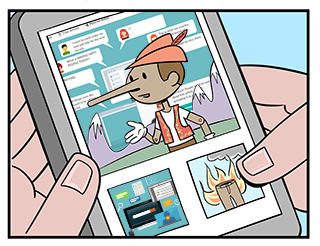Fake it to make it

Created by a designer and game developer named Amanda Warner, Fake It To Make It places players in the shoes of an unethical propagandist who spreads disinformation in search of advertising revenue.
In a review written for The Verge, Megan Farokhmanesh explains the basic game mechanics:
Once you’ve decided on your financial goal, your time is spent either copying articles from other sites, or writing your own fake news to peddle through different social media accounts. There’s a delicate balance between first crafting (or copying) an article that is believable and creates the right amount of drama, and using the right channels to spread it. If you have a political post, for example, you wouldn’t drop it into one of the meme or parenting-focused groups. As articles spread and grab attention, they’ll start to pull in money. 1
Why would someone create this type of game? In an explanation posted on her site, Warner explains her desire to influence the actions, attitudes and beliefs of those who play the game. Specifically, she hopes that the game will teach players to:
- help stop the spread of disinformation,
- recognize the difference between genuine journalism and fake news,
- understand the financial incentives motivating the distribution of fake news, and
- recognize common persuasive techniques such as emotional appeals, confirmation bias, card-stacking (partial truths), and misleading specificity. 2
“I think that better understanding how and why were are manipulated by others, for profit or power, is worthwhile knowledge to have,” adds Warner.
The game has been popular with educators and journalists, with one reviewer describing it as “a hilarious and terrifying look at how quickly fake news can spawn and be spread across the Internet.” 3
Fake It To Make It is playable on a mobile phone, but Warner recommends playing the game on a device with a wider screen.
As you play the game, we encourage you to make connections to the persuasive techniques, logical fallacies, and cognitive biases that you have read about on this site. How many of these techniques do you recognize?
References
1 Megan Farokhmanesh (2017, March 27) “Live a day in the life of a fake news creator,” The Verge.
2 Amanda Warner (2017), “About Fake It To Make It,” Fake It To Make It.
3 Mary-Ann Russon (2017, March 28), “Fake It To Make It: The scarily realistic game that simulates spread of viral clickbait fake news,” International Business Times.
